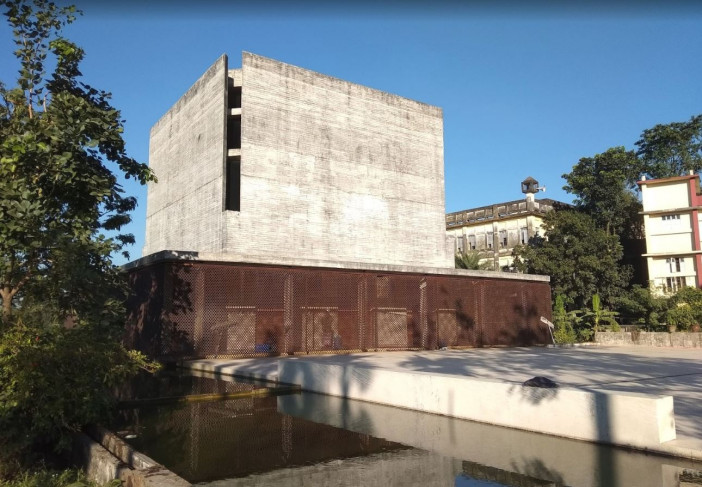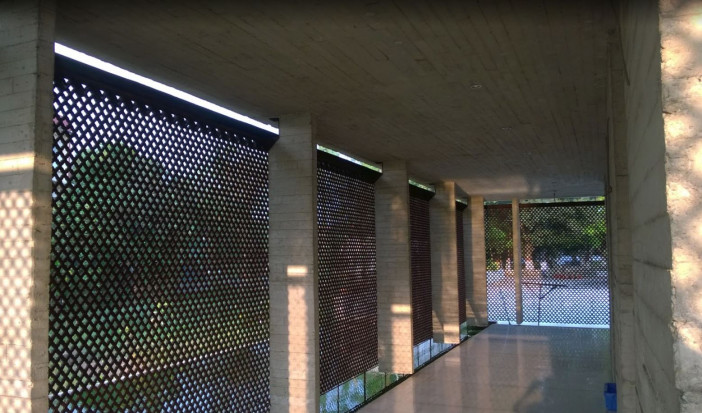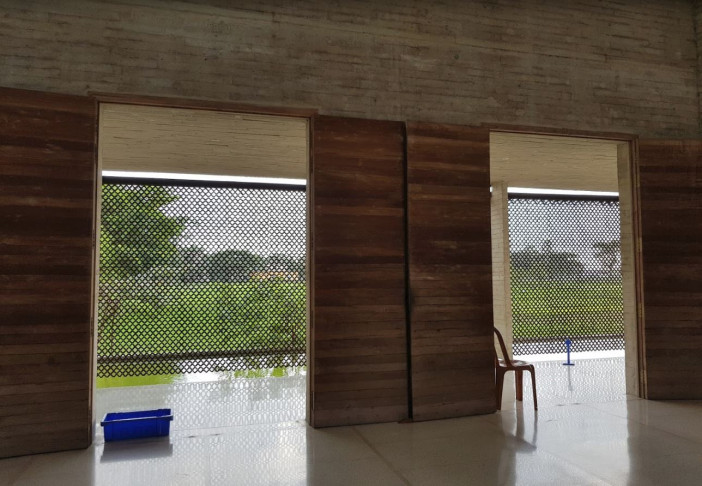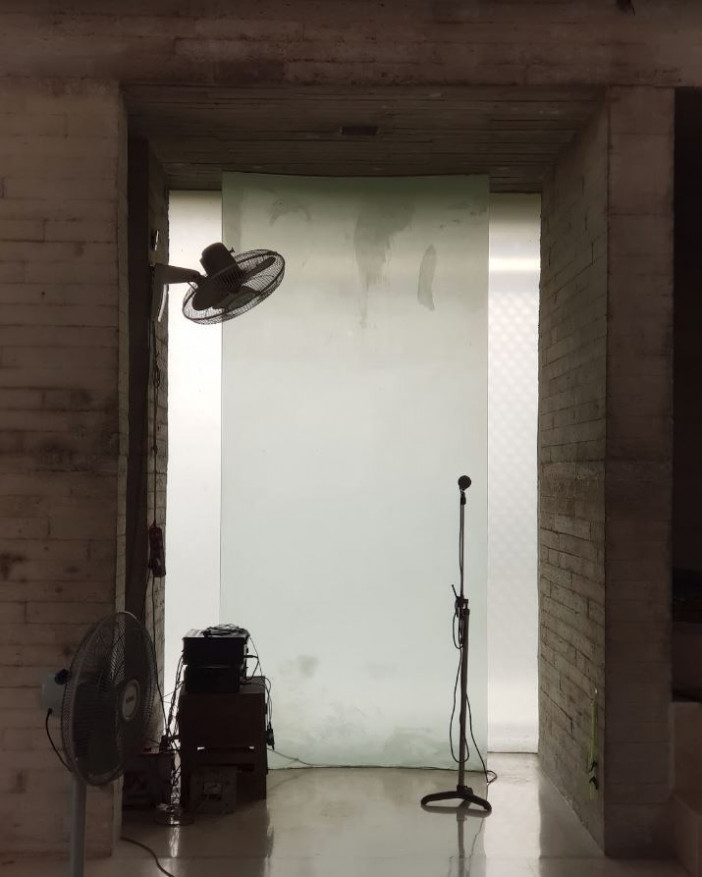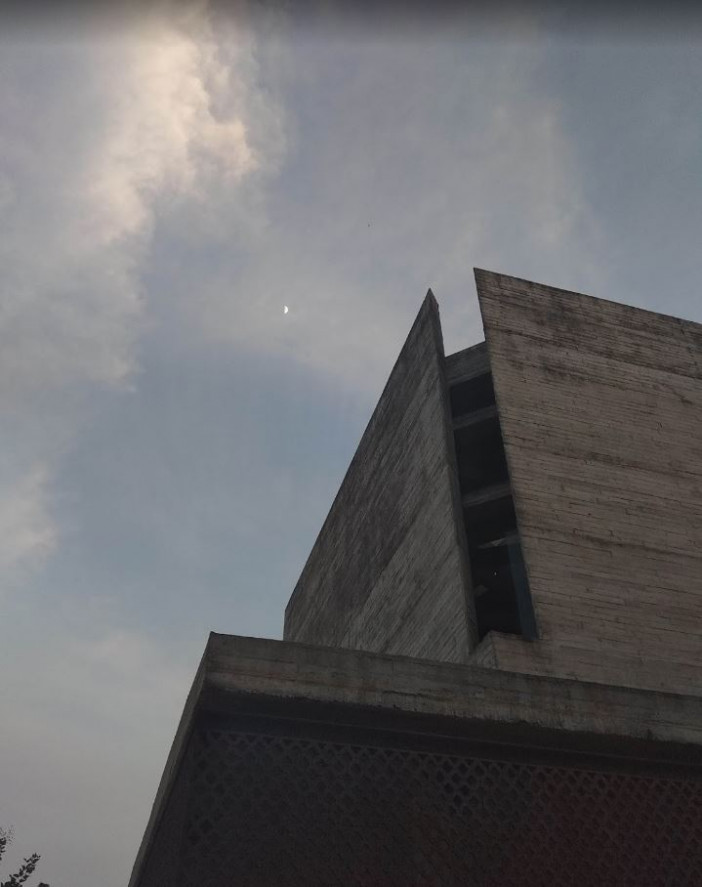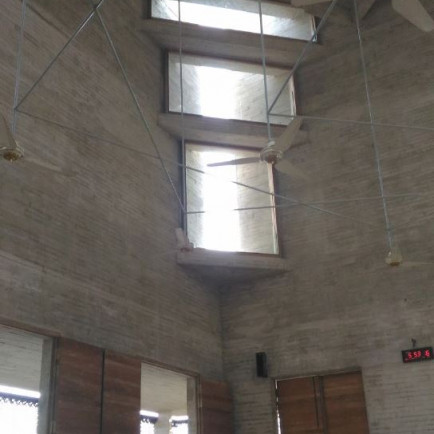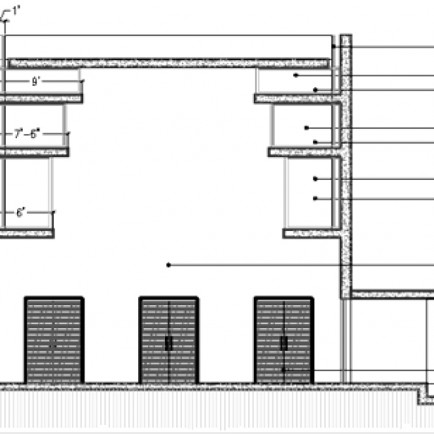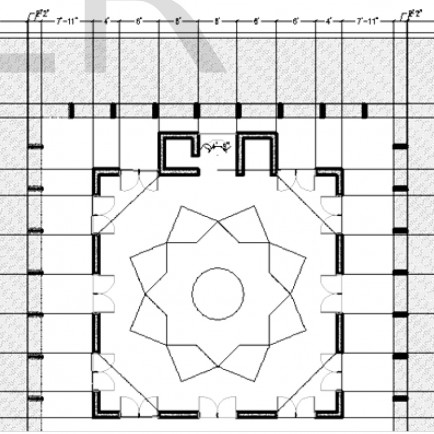Concrete Mosque
Urban and Architectural
Existence of a 220-year old mosque at site, conserved from its dilapidated conditions, was a generator of the new scheme. The new structure is designed in such a way that it forms a backdrop to the old mosque – an act of reversal in which the past is brought to the fore and the new comes after the old. Echoing the volumetric rise of the traditional dome in a mosque, the central cuboid volume of the mosque emerges like a modern monolith, embellished on the outside with only the heavy textures of white concrete cast in wood. The lower volume is clothed in a cast-iron grille – which, generated from a traditional motif of the old mosque, provides security and shade but also lets in filtered light and breeze.
The grille protects an ambulatory space which itself gives protection to the main prayer hall, whose doors can be left open for ventilation during heavy rain. An experiential climax occurs when one enters the main hall with its soaring volume animated by light entering through slender apertures in corners and the ceiling. The new building uses entirely natural means to accommodate the tropical climate of its site. The generous central volume with its high windows uses the stack effect to ventilate the space naturally.
To further facilitate micro-climatic cooling, a pond on the south - the predominant direction of airflow - is augmented by shallow pools on three sides of the mosque. Scented flower bearing trees have been planted in specific positions to grant an olfactory experience to visitors. The architecture was inspired by the age-old heritage of crafted ornament in the various traditions of mosque building.
From the outside, however, the treatment is spare: Only the texture of the concrete is caught by sunlight. Inside, the ceiling structure and finishes, inspired by Moghul and Nasrid examples, serve as a counterpoise to the otherwise bare, simple treatment everywhere. A departure for the architect in using such treatments, it is an ode to the craftsmanship and mastery of techniques which have adorned great mosques since centuries past.
Description
Concrete Moshjid is an example of contemporary mosque. It is constructed at 2015. It is located at the back of old Asgar Ali Chowdhury Jame Moshjid which was built over 200 years ago. The old mosque is now conserved as a heritage building. The newly build mosque is surrounded by agricultural land and beautiful nature. There is a ‘Shaan’ space in front of it along with a small water body to the South.
The old mosque is adjacent to the ‘Shaan’ space. In front of the old mosque there is a 12 feet wide road and a big pond beside the road. A primary school is located at the North-West corner of the mosque. There is no mentionable noise source in this area rather it’s a quiet and calm place blended with nature. The composition of materials in this mosque is some reflective and absorbing materials which are rough concrete wall, huge wooden doors, some glass works at the top corners. Ceiling is composed with rough concrete and glass. All areaof the floor is covered by mosaic floor finishing. A square plan mosque with a cubic form is very significant.
The semi outdoor space is surrounded by massive steel Jali (net). The main prayer hall is consists of a square plan of 38’-0’’ X 38’- 0” and height of 38’-0”. The main prayer hall of this mosque has an estimated volume of 54,872 cubic feet and a floor area of 1444 square feet. No extra acoustical design is noticeable in this mosque.
Details
Location
Port Connecting Rd, Chittagong, Bangladesh
Owners
Osman K Chowdhury and family
Architect Name
Kashef Chowdhury/ URBANA
Year of Build
2014
Area
438 sqm
Drawings
Map
Urban and Architectural
Existence of a 220-year old mosque at site, conserved from its dilapidated conditions, was a generator of the new scheme. The new structure is designed in such a way that it forms a backdrop to the old mosque – an act of reversal in which the past is brought to the fore and the new comes after the old. Echoing the volumetric rise of the traditional dome in a mosque, the central cuboid volume of the mosque emerges like a modern monolith, embellished on the outside with only the heavy textures of white concrete cast in wood. The lower volume is clothed in a cast-iron grille – which, generated from a traditional motif of the old mosque, provides security and shade but also lets in filtered light and breeze.
The grille protects an ambulatory space which itself gives protection to the main prayer hall, whose doors can be left open for ventilation during heavy rain. An experiential climax occurs when one enters the main hall with its soaring volume animated by light entering through slender apertures in corners and the ceiling. The new building uses entirely natural means to accommodate the tropical climate of its site. The generous central volume with its high windows uses the stack effect to ventilate the space naturally.
To further facilitate micro-climatic cooling, a pond on the south - the predominant direction of airflow - is augmented by shallow pools on three sides of the mosque. Scented flower bearing trees have been planted in specific positions to grant an olfactory experience to visitors. The architecture was inspired by the age-old heritage of crafted ornament in the various traditions of mosque building.
From the outside, however, the treatment is spare: Only the texture of the concrete is caught by sunlight. Inside, the ceiling structure and finishes, inspired by Moghul and Nasrid examples, serve as a counterpoise to the otherwise bare, simple treatment everywhere. A departure for the architect in using such treatments, it is an ode to the craftsmanship and mastery of techniques which have adorned great mosques since centuries past.
Description
Concrete Moshjid is an example of contemporary mosque. It is constructed at 2015. It is located at the back of old Asgar Ali Chowdhury Jame Moshjid which was built over 200 years ago. The old mosque is now conserved as a heritage building. The newly build mosque is surrounded by agricultural land and beautiful nature. There is a ‘Shaan’ space in front of it along with a small water body to the South.
The old mosque is adjacent to the ‘Shaan’ space. In front of the old mosque there is a 12 feet wide road and a big pond beside the road. A primary school is located at the North-West corner of the mosque. There is no mentionable noise source in this area rather it’s a quiet and calm place blended with nature. The composition of materials in this mosque is some reflective and absorbing materials which are rough concrete wall, huge wooden doors, some glass works at the top corners. Ceiling is composed with rough concrete and glass. All areaof the floor is covered by mosaic floor finishing. A square plan mosque with a cubic form is very significant.
The semi outdoor space is surrounded by massive steel Jali (net). The main prayer hall is consists of a square plan of 38’-0’’ X 38’- 0” and height of 38’-0”. The main prayer hall of this mosque has an estimated volume of 54,872 cubic feet and a floor area of 1444 square feet. No extra acoustical design is noticeable in this mosque.


